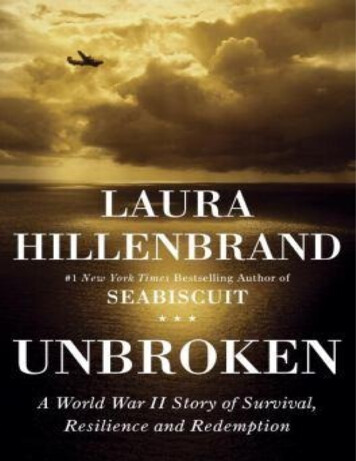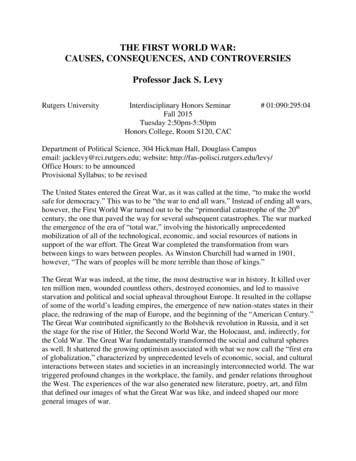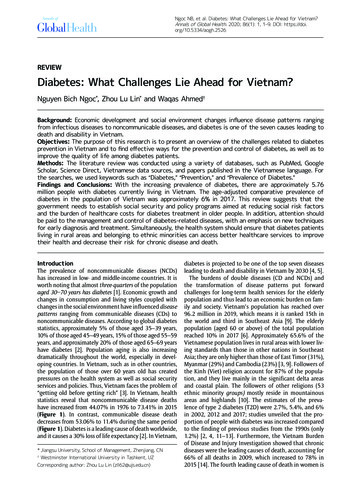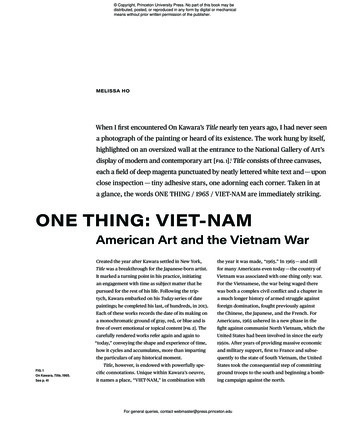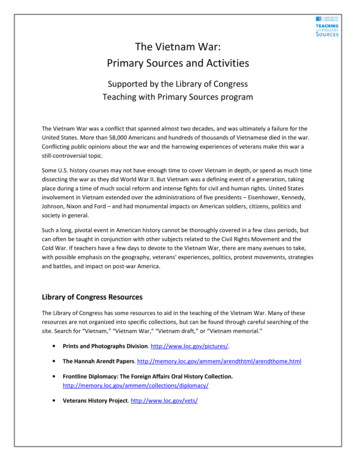
Transcription
The Vietnam War:Primary Sources and ActivitiesSupported by the Library of CongressTeaching with Primary Sources programThe Vietnam War was a conflict that spanned almost two decades, and was ultimately a failure for theUnited States. More than 58,000 Americans and hundreds of thousands of Vietnamese died in the war.Conflicting public opinions about the war and the harrowing experiences of veterans make this war astill-controversial topic.Some U.S. history courses may not have enough time to cover Vietnam in depth, or spend as much timedissecting the war as they did World War II. But Vietnam was a defining event of a generation, takingplace during a time of much social reform and intense fights for civil and human rights. United Statesinvolvement in Vietnam extended over the administrations of five presidents – Eisenhower, Kennedy,Johnson, Nixon and Ford – and had monumental impacts on American soldiers, citizens, politics andsociety in general.Such a long, pivotal event in American history cannot be thoroughly covered in a few class periods, butcan often be taught in conjunction with other subjects related to the Civil Rights Movement and theCold War. If teachers have a few days to devote to the Vietnam War, there are many avenues to take,with possible emphasis on the geography, veterans’ experiences, politics, protest movements, strategiesand battles, and impact on post-war America.Library of Congress ResourcesThe Library of Congress has some resources to aid in the teaching of the Vietnam War. Many of theseresources are not organized into specific collections, but can be found through careful searching of thesite. Search for “Vietnam,” “Vietnam War,” “Vietnam draft,” or “Vietnam memorial.” Prints and Photographs Division. http://www.loc.gov/pictures/. The Hannah Arendt Papers. html Frontline Diplomacy: The Foreign Affairs Oral History /diplomacy/ Veterans History Project. http://www.loc.gov/vets/
Vietnam War Primary-Source Set:Sources and ActivitiesThis primary source set is a first step in harnessing some of the Vietnam War sources from variousplaces on the Library of Congress website. This set collects and organizes the sources into three in-classactivities for high school students, to teach about three particular elements of the war: The Geography of Vietnam Vietnam Veterans’ Experiences Words of Vietnam-Era PresidentsThe sources and activities here provide teachers with activity suggestions that can occupy one classperiod or less. The inclusion of one Minnesota source helps to make the connection between state andnational history, illustrating that events on the national stage also played out in Minnesota. Library ofCongress sources include: Franklin D. Roosevelt Inaugural Address, 1945.Lyndon B. Johnson Inaugural Address, 1965.Vietnam demarcation line and demilitarized zone, 1966. Map.China—North Vietnam boundary area, 1967. Map.Richard M. Nixon Inaugural Address, 1969.Cambodia, South Vietnam, 1970. Map.South Vietnam population and administrative divisions, 1972. Map.Richard M. Nixon Inaugural Address, 1973.Floyd Harold Kushnar Memoir Excerpt. 2000.Vietnam map, 2001. Map.Rhona Marie Knox Prescott Interview Excerpt. 2002.Thomas H. Hodge Interview Excerpt. 2002.Larry Schwab Interview Excerpt. 2003.Minnesota sources (from the Minnesota Historical Society) include: Michael Traynor. “The Reception Home.” 1968 Reflections.
The Vietnam War: ContextThe South Vietnamese, aided by the United States,fought against North Vietnam after the departure ofFrench occupation in the early 1950s. The UnitedStates justified involvement in the war as a means ofsupporting the non-communist South Vietnam, partof its policy of Communism containment.In the early 1960s, President Kennedy sent U.S.troops to Vietnam to train South Vietnamese soldiersin guerilla warfare and act as advisers to thegovernment, in order to halt the spread ofcommunism moving in from North Vietnam. SouthVietnamese President Ngo Dinh Diem grew inunpopularity, however, partly due to his repression ofBuddhism, and was assassinated in 1963 by the SouthVietnamese Army.“Congressman Alexander Pirnie reaching into a container of draft numbers(center) as others look on at the Selective Service Headquarters duringthe nationwide draft lottery.” 1969. Library of Congress.Following a North Vietnamese attack on a U.S. ship in 1964, the U.S. Congress granted President Johnson thepower to conduct military operations in Vietnam. The United States launched its first aerial attack against theNorth Vietnamese Army, also called Viet Cong, in 1965. Between 1964 and 1969, the number of American troopsin Vietnam increased from 16,000 to 553,000. The U.S. government used a draft lottery system beginning in 1969.Throughout the 1960s, the U.S. government and military assured the American public that victory in Vietnam wasjust around the corner. After the Tet Offensive in January 1968, American media and the public began to recognizethat the war was at an impasse. Support dwindled, and protests exploded across the United States.When President Nixon took office in 1969, he advocated a policy of “Vietnamization,” which would equip theSouth Vietnamese with the tools necessary to defend themselves, allowing the United States to withdraw. Chinaand the Soviet Union, however, continued their support of fellow communist nation North Vietnam, providingthem with weaponry that enabled their continued warfare against South Vietnam.Ultimately, the United States continued official involvement in Vietnam until January 1973, when the Paris PeaceAccords were signed. The United States withdrew its troops and exchanged prisoners of war. In 1975, SouthVietnam surrendered to and merged with North Vietnam.The failure of the Vietnam war created an atmosphere of frustration and distrust among the American people,agitated by the release of the Pentagon Papers in 1971. American troops returned home to a country that wasbitter about the war, and many of them did not receive the support they needed.Minnesota Involvement in the Vietnam WarMore than 68,000 Minnesotans served in the Vietnam War, including many women who served as nurses. Ofthose, almost 1,100 died and 43 were missing in action. In 1992, the Minnesota Vietnam Veterans Memorial wascompleted on the grounds of the State Capitol building to honor those who served but did not return.
The Geography of VietnamLibrary of Congress documents for this activity:Vietnam map, 2001. http://www.loc.gov/item/2002630432Vietnam demarcation line and demilitarized zone, 1966. http://www.loc.gov/item/75690898China—North Vietnam boundary area, 1967. http://www.loc.gov/item/80691579Cambodia, South Vietnam, 1970. http://www.loc.gov/item/gm%2070004427South Vietnam population and administrative divisions, 1972. http://www.loc.gov/item/75690894Activity Procedure:Understanding the geography of war is essential to understanding the war. If students are not familiarwith the geographic locations of the nations at war, as well as political boundaries and other features, itis more difficult to visualize the war that took place. These maps will help provide a foundation forfuture discussions of the Vietnam War, the locations of critical events, and the involvement ofsurrounding nations.1. If possible, enlarge the 2001 map to poster size and hang it at the front of the room. Talk aboutthe features of the modern map and get students oriented to the shape of Vietnam and thesurrounding countries. (You may want to show a map of the world, too, to orient students to thelocation of Vietnam).2. Divide the students into small groups and give each group one of the other four maps – eitherenlarged to poster size or on the Library of Congress website so they can zoom in and out – anda stack of Post-It notes. (For best effect, assign a different color Post-It note to each map).3. Have students examine their individual maps and make notes about what the map portrays,especially in regards to boundaries, roads, populations, cities and cultural identification. Inaddition, have them make notes about any specific differences they see between their map andthe large 2001 map.4. After the students have examined the maps more closely, have them make notes on the Post-Itsabout some of the identifying features that stand out on their map (for example: the map ofSouth Vietnam population and divisions labels the capitol of the country as Saigon, whereas onthe 2001 map, it is no longer a capitol and is called Ho Chi Minh City). All groups should placethe Post-It notes on the appropriate places on the large map.5. Come back together as a large group and talk about what the Post-It notes reveal. Students fromsmaller groups should talk in general about their maps and explain their Post-It choices.
Vietnam Map, 2001. Map. Library of Congress.
Vietnam demarcation line and demilitarized zone, 1966. Map. Library of Congress.
China - North Vietnam boundary area, 1967. Map. Library of Congress.
Cambodia, South Vietnam, 1970. Map. Library of Congress.
South Vietnam population and administrative divisions, 1972. Map. Library of Congress.
Vietnam Veterans’ ExperiencesMinnesota documents for this activity:Michael Traynor 1968 Reflection, “The Reception s/minnesotahistorycenter.org/files/files/12EX0001s reflections%20(1).pdfLibrary of Congress documents for this activity:Larry Schwab Interview Excerpt. afc2001001.23979/Rhona Marie Knox Prescott Interview .natlib.afc2001001.01146/Thomas H. Hodge Interview Excerpt. afc2001001.03736/Floyd Harold Kushnar Interview Excerpt. afc2001001.65249/Activity Procedure:The Vietnam War, fought between the North Vietnamese, and the United States (with the aid of theSouth Vietnamese) lasted officially more than 15 years, although U.S. ground troops were present inVietnam from 1964-1973. The experiences of Vietnam War veterans vary widely, as do their views of thewar and their reception by the U.S. public. The Library of Congress Veterans History Project hashundreds of stories of Vietnam veterans chronicling their varied experiences. Reading the first-personinterviews will provide a personal, emotional look at the years of war.1. As a class, read Michael Traynor’s account of his Vietnam experience, “The Reception Home.”Talk about students’ reactions to this story. How would they characterize Traynor’s experience?2. Divide students into four groups and assign each group a veteran’s story from the list above.Have each group read their story out loud and then discuss their veteran’s experience of war.What was the veteran’s impression of war? What is the main point of their reminiscence?3. In each group, have the students brainstorm three words or phrases that they think describetheir veteran’s war experience. Next, the group should choose one sentence that they thinkmost powerfully describes their veteran’s memories.4. Come back together as a class. Each group will take turns introducing their veteran: name,occupation (if known), basic understanding of the veteran’s experience, the three words andphrases, and the quote.5. As a class, discuss the students’ impressions of these stories. Do these veteran’s experiencesconfirm or change their previous thoughts about Vietnam veterans? What do these storiesexpress about the differences and similarities in veterans’ experiences? How do you feel towardthese veterans? The U.S. government? Those the soldiers fought against?6. As an extension: Each student will go into the Veterans History Project at the Library of Congressand find a veteran’s story that interests them, and then perform this same exercise with thatveteran. The students will document their findings and turn those in for assessment.
Michael Traynor“The Reception Home”Coming home was really hard. That was probably the worst part. We were all so happy to come home.When that plane took off in Vietnam, the cheers and the roars inside the plane was almost deafening,because we were so happy to be getting out of there and going home. Going back to the world, that’swhat we called it. Vietnam was Vietnam, or Vietnam Republic of. We were going back to the world .When we got back to the good old USA we knew we were safe. We found out how unsafe we reallywere. The protesters, or the people would spit on us. The people that said whatever we got over there,we deserved it, for being over there. It was just total lack of respect.When I got home, my wife (now ex) told me that she didn’t want to hear anything about it. And I wasliterally choking trying to talk to somebody but nobody wanted to hear it it was not a popular war, itwas also not a war that we were winning. We won WW2, WW1, we always won. Vietnam we did notwin, it was not popular. So we weren’t afforded the same courtesy as any other Vet. Even KoreanVeterans had said the same thing. They were told the same thing. It was a police action not a war.Other 1968 Reflections (from the 1968 Exhibit, Minnesota Historical s reflections%20(1).pdf
Larry Schwab I was drafted and reported in early September and army field service school lasted approximately fiveweeks. And after that time I think we had eight or ten days of ordinary leave. So my wife and I droveback from San Antonio to Morgantown, [WV] and I spent that short one week or less time with myfamily and then I simply got on a plane and flew to San Francisco, and reported at Oakland Army baseand waited for four days until there was a commercial aircraft that took us to Vietnam. But it was awrench to leave everything that you had come to expect and to be forced by my country, my nation, myculture to enter a conflict which was violating what I thought were basic human principles. So it was adifficult transition. And especially when you are thrust into the maul, into the unknown and you knowthat people are dying and being maimed in that conflict already. And you wonder about your ownsafety. And of course when you get on a plane and leave American soil to fly there, you wonder if you'llcome back alive or if you arrive in a steel box like a lot of the soldiers that I served beside did. Or theymay have gone home through a system maimed without limbs or with serious injuries through medicalevacuation system through Southeast Asia or Japan. So those questions are always on your mind whenyou enter such a violent event as the American Vietnam War turned out to be The worst four hours of my life, that I'm still having nightmares about and combat dreams. But neveronce did anyone think that their doing this to get an award, or a medal. What you're trying to do issurvive and in my case I was trying to take care of nineteen-year-old kids that had been maimed andwere missing limbs and had 90% second and third degree bums and the soldiers aren't thinking ofcountry and the flag at that time either. They wanted something for pain, and they wanted water andthey wanted their mothers. And the pathos of bombs and exploding rockets, and small arms fire, tonineteen-year-old kids; it pure pathos to think that I heard that, and I saw that, and but it wasn't countryand liberty and freedom and democracy hear most of these kids die that they were there for. Theyweren't fighting for that. They were fighting to stay alive and to come home. And that's why I have realissue with that as a political slogan that these men died for their country. They didn't die for theircountry, they died for each other maybe, but they didn't want to die. But no soldier that I saw seriouslyinjured or maimed or thought he might die, ever said the first thing about the flag or the country. Theywere thinking of their families. And the majority of the ones that I saw there in that situation weredrafted. And it since you can consider extended that logic that our own culture and political system sentthem off to their deaths unwillingly because they were conscripted and forced to serve and they putthem in harm’s way.Full transcript and digital oc.natlib.afc2001001.23979/
Rhona Marie Knox PrescottWhen we came down it was daylight; Vietnam from the air is gorgeous. It is all green like Ireland, allshades of green. You can see the divisions of the rice paddies separated by hand made dikes. It is veryhilly and fertile and of course it has the sea all around it. It was gorgeous coming down When I came down it radically changed. We were not allowed to disembark right away from theairplane. We were told to put on our helmets and to run single file to a site on the tarmac- to go asquickly as possible and not to look back. When the doors opened the heat just kind of hit us in the face.It was really hot in Vietnam; it was close to one hundred thirty degrees. We were being fired at; therewere snipers there along the runway; somewhere in the bushes― that they hadn't been able to remove.We were just to run, so that we did. Nobody got shot. It was a real eye-opener! The hospital was a series of tents; big green tents held up by poles with stakes into the ground. Thefloor was a tent liner which was just a kind of plastic and canvas material that sat on the ground thatwas lumpy. There was of course no air conditioning, the tent flaps were left open. It was hot. The FirstCalvary had a helicopter unit. There were a lot of helicopters flying over which pulled up with theirrotors a lot more of the dusty clay. So, it was not only hot, it was really dirty; there was just dirt flying allthe time and it was hotter than Hades during the day and it got really cold at night . It wasn't really safe. The stuff was old. Since I was acting chief nurse I decided that the casualtieswould all just go into the receiving tent where there was more room and more tables and where thedoctors posted themselves. That tent became our surgery. It was beyond primitive; it was beyond theMASH movie and TV show. It was dirty; it was a non-sterile environment. We didn't have enoughinstruments. We didn't have enough hands. Needless to say we shared things during surgical proceduresthat were absolutely needed to save lives, but they weren't sterile. We didn't have suction, we didn'thave penicillin to irrigate wounds, didn't have enough blood to transfuse, we just didn't have. We didhave so many casualties right out of the field. They just brought them all in there. The First Cav. put theirpeople in that staging unit hoping that we could fix them and send them back into the war. So, we were[sigh] way above our heads When we were busy (which was most of the time) you had to some how block out the smells and thesounds because the smells were of dirty, putrefied flesh and blood that was some running free andsome that was old. There were insects and there was dust and other organic material that didn't smellgood in the area. The sounds were of people crying and screaming and praying and then there werepeople on our own staff who were also pretty flustered and uttering back and forth. The sounds werechaotic. The smells were astounding and the only way to function was to somehow block those thingsfrom sensory perception or you couldn't go on. So that is what we did and I don't know how we did it. Iguess there is some innate gift in all of us and I really think it was the hand of God there.Full interview transcript and digital oc.natlib.afc2001001.01146/
Thomas H. Hodge After I finished boot camp and advanced infantry training, they sent me to Motor Transport school. Igot to Vietnam, I was a truck driver. When I got my orders in boot camp, they told me that the lifeexpectancy for a truck driver was three days It's like you go to a amusement park, and you have the ducks running along in a line and you'reshooting at them, and that's about the size of a truck driver in Vietnam. If you're not doing that thenyou're doing duty that is comparable, and you're carrying explosives. So, I have a picture here that I cankind of show you of -- this is the -- we're running convoys, and the convoys always had machine gunnersevery fifth truck. We run about a 30, 40 truck convoy. We have maybe three tanks. Three tanks at thebeginning of the convoy, maybe two tanks in the middle of the convoy, and two or three tanks at theend of the convoy. And if one of the -- if a round hits one of the artillery rounds, something like that, the whole convoygoes up in a row. We also haul aviation fuel, JP-4, for the helicopters. And this was a everyday thing, 365days of the year we run convoys, there wasn't no Sunday, Monday, or Tuesday We never kept track of the days. It was just a survival every day It’s something you don't learn fromschool. It's something that you get into and once it's -- your mind has to get -- you have to go into a coldmind. You know, when I say that, you know, if a buddy of yours gets shot and killed, you have some guysflip out, and once you see this happen day in, day out -- other -- the enemy getting killed, you got bodieslaying here and there. Your mind starts to get cold Doing truck driving, we run 18-hour days. In the Marine Corps you're guaranteed one hour of sleep aday and one meal. Every day. That's what you're guaranteed, so this was all part of the training that wegot. It wasn't really the training, when you come up to boot camp, you got three meals a day. Once theysay you hit Vietnam, you're guaranteed one meal a day, and that was it. And one hour of sleep a day.Some days I would go for two, sometimes three days without getting sleep. And we -- we don't even-- sometimes we don't even take our clothes off for four or five days, youknow. If it's monsoon season we're getting soaking wet. We weren't wet from sweat, we're wet fromthe rain, so sometimes I've been-- I've been where I haven't taken by boots off for like two weeks. Yourboots, once you get them off, you can't get them back on because they're wet, and you can't get themback on, so you just leave them on Full interview transcript and digital oc.natlib.afc2001001.03736/
Floyd Harold Kushner The first day they took me to a cave, stripped my fatigue jacket off my back, tied me to a door and ateenage boy beat me with a bamboo rod. I was told his parents were killed by American bombs. Werested by day, and marched by night. I walked on rice paddy dikes, and couldn't see a thing. They wouldstrike these little homemade lighters and by the sparks they made, see four or five steps. I was alwaysfalling off the dikes into the rice paddy water and had to be pulled back up. It was rough. On the way, Isaw men, women and kids in tiger cages, and bamboo jails. I was taken to a camp, which must havebeen a medical facility as my wound was festering and full of maggots and I was sick. A woman heatedup a rifle-cleaning rod and gave me a bamboo stick to bite on. She cauterized my through and throughwound with the cleaning rod and I almost passed out with pain After walking for about a month through plains, then jungles and mountains, always west, they tookme to a camp. I had been expecting a PW camp like a stalag with Hogan's Heroes; barbed wire, searchlights, nice guards and Red Cross packages - and a hospital where I could work as a doctor. They took meto a darkened hut with an oriental prisoner who was not American. I didn't know whether he wasVietnamese, Cambodian, Laotian or Chinese. He spoke no English and was dying of TB. He wasemaciated, weak, sick and coughed all day and night. I spent two days there and an English-speakingVietnamese officer came with a portable tape recorder and asked me to make a statement against thewar. I told him that I would rather die than speak against my country. His words which wereunforgettable and if ever write a book, will be the title. He said, "You will find that dying is very easy;living, living is the difficult thing." We were held in a series of jungle camps from Jan. ‘68 to Feb. ‘71. At this time, conditions were so badand we were doing so poorly, that they decided to move us to North Vietnam. They moved 12 of us. Inall, 27 Americans had come through the camp. Five had been released and ten had died. They died oftheir wounds, disease, malnutrition and starvation In the North we were in a rough jail. There was bucket in the windowless, cement room used as alatrine. An electric bulb was on 24 hours. We got a piece of bread and a cup of pumpkin soup each dayand three cups of hot water. We slept on pallets of wood and wore PJs and sandals and got three tailormade cigarettes per day. We dry shaved and bathed with a bucket from a well twice per week, got outof the cell to carry our latrine bucket daily. Towards the end, they let us exercise It was hard duty, but not the grim struggle for survival which characterized daily life in the camps inthe south. In the north, I knew I would survive. In the south, we often wanted to die. I knew that whenthey ordered us north, I would make it. In the south, each day was a struggle for survival Full memoir and digital oc.natlib.afc2001001.65249/
Words of Vietnam-Era PresidentsLibrary of Congress documents for this activity:Franklin D. Roosevelt Inaugural Address, 1945. n B. Johnson Inaugural Address, 1965. rd M. Nixon Inaugural Address, 1969. rd M. Nixon Inaugural Address, 1973. ity Procedure:The United States was present in Vietnam from the early 1960s through 1975, spanning four presidentialadministrations. But Lyndon Johnson and Richard Nixon were the presidents whose terms covered muchof the war and whose decisions affected the majority of the outcomes of the war. Both presidents faceddifficult decisions, opposition from their citizens and soldiers, the effects of their and their predecessors’political choices, and a war that became unwinnable.1. On the board, make a comparison chart between World War II and Vietnam. In each of thecolumns, have students brainstorm words or phrases that describe each of these wars (payparticular attention to length of war, public opinion, reasons for entering the war, and nationsinvolved).2. Discuss with the class the list of World War II words. How do the students think the public imageof the war, the motivation behind the war, and the outcomes affected Roosevelt’s presidency?3. Now have the same discussion about Vietnam. How do the students think all of these factorsaffected Johnson and Nixon’s presidencies?4. Open up Roosevelt’s final inaugural address on the computer and copy the text. Paste the textinto a word cloud (wordle.net or tagxedo.com) and project the results. Which words are biggest(which means they appear the most in the text)? How does that reflect your assessments aboutRoosevelt’s presidency?5. Now do the same for Johnson’s second address and both of Nixon’s addresses. Compare thethree Vietnam-era addresses, paying particular attention to the biggest words and what thatreflects about the two presidents’ priorities and the times in which they were speaking.Additionally, what differences, if any, do you see between Nixon’s two addresses?6. Extension activity: Have each student create their own word cloud of either Johnson’s or Nixon’srhetoric, using a State of the Union address, message to Congress or a news conference, andthen write a brief summary of what the word cloud reflects about the president and the war.Rhetoric can be found at the American Presidency Project: http://www.presidency.ucsb.edu/.
Fourth Inaugural Address of Franklin D. RooseveltSATURDAY, JANUARY 20, 1945Mr. Chief Justice, Mr. Vice President, my friends, you will understand and, I believe, agree with my wishthat the form of this inauguration be simple and its words brief. We Americans of today, together withour allies, are passing through a period of supreme test. It is a test of our courage--of our resolve--of ourwisdom--our essential democracy. If we meet that test--successfully and honorably--we shall perform aservice of historic importance which men and women and children will honor throughout all time.As I stand here today, having taken the solemn oath of office in the presence of my fellow countrymen-in the presence of our God-- I know that it is America's purpose that we shall not fail. In the days and inthe years that are to come we shall work for a just and honorable peace, a durable peace, as today wework and fight for total victory in war. We can and we will achieve such a peace. We shall strive forperfection. We shall not achieve it immediately--but we still shall strive. We may make mistakes--butthey must never be mistakes which result from faintness of heart or abandonment of moral principle.I remember that my old schoolmaster, Dr. Peabody, said, in days that seemed to us then to be secureand untroubled: "Things in life will not always run smoothly. Sometimes we will be rising toward theheights--then all will seem to reverse itself and start downward. The great fact to remember is that thetrend of civilization itself is forever upward; that a line drawn through the middle of the peaks and thevalleys of the centuries always has an upward trend." Our Constitution of 1787 was not a perfectinstrument; it is not perfect yet. But it provided a firm base upon which all manner of men, of all racesand colors and creeds, could build our solid structure o
The Vietnam War was a conflict that spanned almost two decades, and was ultimately a failure for the United States. More than 58,000 Americans and hundreds of thousands of Vietnamese died in the war. Conflicting public opinions about the war and the harrowing experiences of veterans ma





